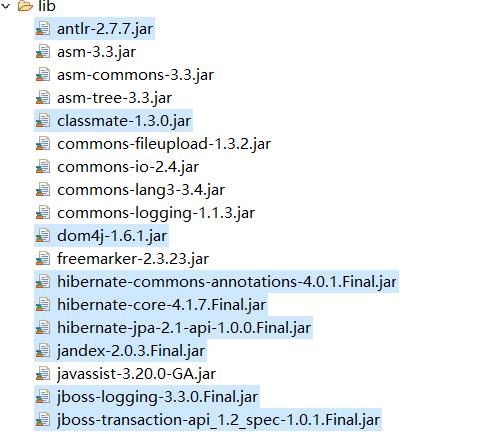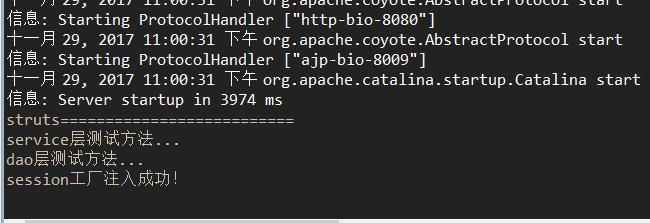eclipse环境下基于已构建struts2项目整合spring+hibernate
Posted Mr至简
tags:
篇首语:本文由小常识网(cha138.com)小编为大家整理,主要介绍了eclipse环境下基于已构建struts2项目整合spring+hibernate相关的知识,希望对你有一定的参考价值。
本文是基于已构建的struts2项目基础上整合
spring+hibernate,若读者还不熟悉struts2项目,请先阅读
eclipse环境下基于tomcat-7.0.82构建struts2项目
实现步骤:
第一步:引入spring所需jar包,如下图所示:

第二步:导入hibernate所需jar包,如下图中被选中jar文件:

第三步:导入struts-spring整合包,暂且就这么称呼吧

第四步:导入mysql驱动包:

第五步:所有准备工作就绪后,接下来创建spring与hibernate配置文件,命名为applicationContext.xml,配置如下所示:
<?xml version="1.0" encoding="UTF-8"?> <beans xmlns="http://www.springframework.org/schema/beans" xmlns:xsi="http://www.w3.org/2001/XMLSchema-instance" xmlns:context="http://www.springframework.org/schema/context" xmlns:task="http://www.springframework.org/schema/task" xmlns:tx="http://www.springframework.org/schema/tx" xmlns:aop="http://www.springframework.org/schema/aop" xsi:schemaLocation=" http://www.springframework.org/schema/beans http://www.springframework.org/schema/beans/spring-beans-3.0.xsd http://www.springframework.org/schema/context http://www.springframework.org/schema/context/spring-context-3.0.xsd http://www.springframework.org/schema/task http://www.springframework.org/schema/task/spring-task-3.1.xsd http://www.springframework.org/schema/tx http://www.springframework.org/schema/tx/spring-tx-3.0.xsd http://www.springframework.org/schema/aop http://www.springframework.org/schema/aop/spring-aop-3.0.xsd "> </beans>
这是spring配置文件命名空间的引入,命名空间具体含义请参考前辈资料
6.2.3 Spring 2.5配置文件详解(1)
第六步:在web.xml文件中配置对spring的监听,配置如下所示:
<?xml version="1.0" encoding="UTF-8"?>
<web-app xmlns:xsi="http://www.w3.org/2001/XMLSchema-instance" xmlns="http://java.sun.com/xml/ns/javaee" xsi:schemaLocation="http://java.sun.com/xml/ns/javaee http://java.sun.com/xml/ns/javaee/web-app_3_0.xsd" id="WebApp_ID" version="3.0">
<display-name>SSHDemo</display-name>
<!-- spring的监听器配置开始 -->
<!-- spring监听器的作用:提供实例(IOC) -->
<context-param>
<param-name>contextConfigLocation</param-name>
<param-value>classpath:applicationContext.xml</param-value>
</context-param>
<listener>
<listener-class>org.springframework.web.context.ContextLoaderListener</listener-class>
</listener>
<!-- 将请求路径交由struts过滤 -->
<filter>
<filter-name>struts2</filter-name>
<filter-class>org.apache.struts2.dispatcher.ng.filter.StrutsPrepareAndExecuteFilter</filter-class>
</filter>
<filter-mapping>
<filter-name>struts2</filter-name>
<url-pattern>/*</url-pattern>
</filter-mapping>
</web-app>
这是在struts2项目基础配置上增加对spring的监听。
第七步:项目下构建业务层接口(TestServiceI)、实现类(TestServiceImpl)以及数据库操作层接口(TestDaoI)、实现类(TestDaoImpl)
整个项目结构如下图所示:

其中dao层实现类中我们需要注入一个session工厂(工厂注入请留意本文后续),接着打开session工厂用于操作数据库,代码如下所示:
package wjt.com.test.dao.impl; import org.hibernate.HibernateException; import org.hibernate.Session; import org.hibernate.SessionFactory; import wjt.com.test.dao.TestDaoI; public class TestDaoImpl implements TestDaoI{ private SessionFactory sessionFactory; public void setSessionFactory(SessionFactory sessionFactory) { this.sessionFactory = sessionFactory; } private Session getCurrentSession() { try { return sessionFactory.getCurrentSession(); } catch (HibernateException e) { return sessionFactory.openSession(); } } @Override public void testDaoMethod() { System.out.println("dao层测试方法..."); if(getCurrentSession()!=null) { System.out.println("session工厂注入成功!"); } } }
其中service层实现类中我们暂时写一个空方法进行测试dao层接口对象的注入成功与否并调用dao层方法,代码如下:
package wjt.com.test.service.impl; import wjt.com.test.dao.TestDaoI; import wjt.com.test.service.TestServiceI; public class TestServiceImpl implements TestServiceI{ private TestDaoI testDao; public void setTestDao(TestDaoI testDao) { this.testDao = testDao; } @Override public void testServiceMethod() { System.out.println("service层测试方法..."); testDao.testDaoMethod(); } }
其中Action层我们在原来struts2项目的基础上注入service层接口并调用其方法,代码如下:
package wjt.com.test.action; import com.opensymphony.xwork2.ActionSupport; import wjt.com.test.service.TestServiceI; public class TestAction extends ActionSupport{ private TestServiceI testService; public void setTestService(TestServiceI testService) { this.testService = testService; } public String execute() throws Exception { System.out.println("struts=========================="); testService.testServiceMethod(); return "success"; } }
整个s2sh项目中的结构布局如上述第七步所示,用于视图映射的类我们封装在action包下,用于实现业务逻辑的我们封装在service包下,用于访问数据库对数据进行操作的我们封装在dao包下。
第八步:配置spring+hibernate的配置文件
截止到现在整个s2sh项目的准备工作已经准备完毕,接下来我们我们配置hibernate的数据源、session工厂,配置spring的核心之一控制反转IOC或称为依赖注入DI。
配置如下:
<?xml version="1.0" encoding="UTF-8"?> <beans xmlns="http://www.springframework.org/schema/beans" xmlns:xsi="http://www.w3.org/2001/XMLSchema-instance" xmlns:context="http://www.springframework.org/schema/context" xmlns:task="http://www.springframework.org/schema/task" xmlns:tx="http://www.springframework.org/schema/tx" xmlns:aop="http://www.springframework.org/schema/aop" xsi:schemaLocation=" http://www.springframework.org/schema/beans http://www.springframework.org/schema/beans/spring-beans-3.0.xsd http://www.springframework.org/schema/context http://www.springframework.org/schema/context/spring-context-3.0.xsd http://www.springframework.org/schema/task http://www.springframework.org/schema/task/spring-task-3.1.xsd http://www.springframework.org/schema/tx http://www.springframework.org/schema/tx/spring-tx-3.0.xsd http://www.springframework.org/schema/aop http://www.springframework.org/schema/aop/spring-aop-3.0.xsd "> <!-- 数据源配置 --> <bean id="dataSource" class="org.springframework.jdbc.datasource.DriverManagerDataSource"> <property name="driverClassName" value="com.mysql.jdbc.Driver" /> <property name="url" value="jdbc:mysql://localhost:3306/wjt_test?useUnicode=true&characterEncoding=UTF-8&zeroDateTimeBehavior=convertToNull&autoReconnect=true" /> <property name="username" value="root" /> <property name="password" value="wujingtao" /> </bean> <!-- 配置hibernate session工厂 --> <bean id="sessionFactory" class="org.springframework.orm.hibernate4.LocalSessionFactoryBean"> <property name="dataSource" ref="dataSource" /> <property name="hibernateProperties"> <props> <prop key="hibernate.hbm2ddl.auto">update</prop> <prop key="hibernate.dialect">org.hibernate.dialect.MySQL5InnoDBDialect</prop> <prop key="hibernate.show_sql">false</prop> <prop key="hibernate.format_sql">true</prop> </props> </property> </bean> <!-- 注入对象 采用属性注入方式--> <bean id="testDao" class="wjt.com.test.dao.impl.TestDaoImpl" scope="prototype"> <property name="sessionFactory" ref="sessionFactory"/><!-- 引用上方的hibernate工厂 --> </bean> <bean id="testService" class="wjt.com.test.service.impl.TestServiceImpl" scope="prototype"> <property name="testDao" ref="testDao"/> </bean> <bean id="testAction" class="wjt.com.test.action.TestAction" scope="prototype"> <property name="testService" ref="testService"/> </bean> </beans>
其中IOC配置采用属性注入的方式,大家可以根据个人喜好选择spring注入的几种方式,我个人偏爱基于注解的属性注入方式,注解方式注入会在后续的文章中给出。
第九步:将struts2运行时的对象交由spring创建,即所谓的应用IOC
在struts.xml配置文件中添加如下配置:
<?xml version="1.0" encoding="UTF-8"?> <!DOCTYPE struts PUBLIC "-//Apache Software Foundation//DTD Struts Configuration 2.3//EN" "http://struts.apache.org/dtds/struts-2.3.dtd"><!-- 这里要和struts2版本号统一 --> <struts> <!-- 告知Struts2运行时使用Spring来创建对象 这行代码是新加的--> <constant name="struts.objectFactory" value="spring" /> <package name="default" extends="struts-default"> <action name="login" class="wjt.com.test.action.TestAction"> <result name="success">index.jsp</result> </action> </package> </struts>
测试项目:
在tomcat下部署并启动项目
浏览器地址栏输入:http://localhost:8080/SSHDemo/login
浏览器显示如下所示:

eclipse输出显示如下:(因为我们在各层有打印信息)

到这里完整的s2sh项目构建完毕并通过测试。
本人是刚毕业的小白,写文章的目的是全当给自己做笔记了,博文有不合理的地方还请读者指出!
以上是关于eclipse环境下基于已构建struts2项目整合spring+hibernate的主要内容,如果未能解决你的问题,请参考以下文章
我用我的Eclipse导入一个struts2的项目能运行...导入个struts2+hibernate项目......tomcat就没法运行..